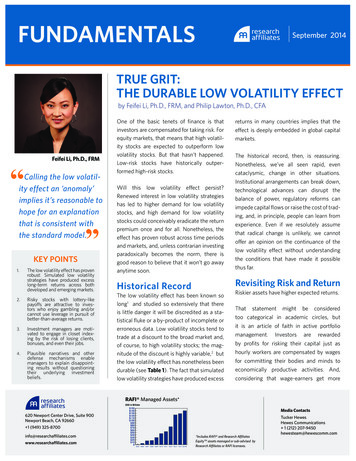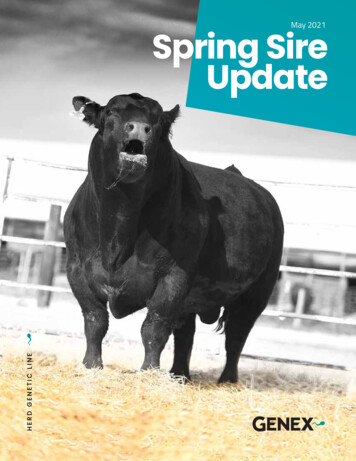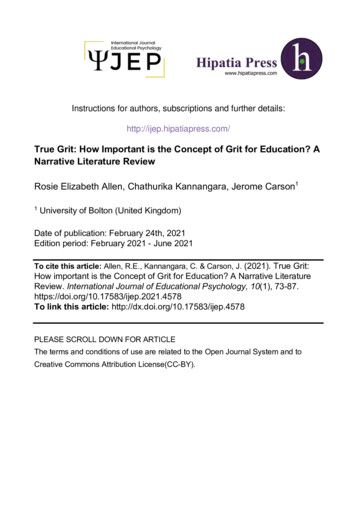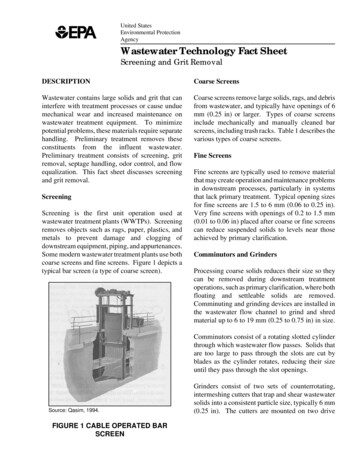
Transcription
FUNDAMENTALSSeptember 2014TRUE GRIT:THE DURABLE LOW VOLATILITY EFFECTby Feifei Li, Ph.D., FRM, and Philip Lawton, Ph.D., CFA“Feifei Li, Ph.D., FRMCalling the low volatility effect an ‘anomaly’implies it’s reasonable tohope for an explanationthat is consistent withthe standard model.“KEY POINTS1.2.The low volatility effect has provenrobust: Simulated low volatilitystrategies have produced excesslong-term returns across bothdeveloped and emerging markets.Risky stocks with lottery-likepayoffs are attractive to investors who enjoy gambling and/orcannot use leverage in pursuit ofbetter-than-average returns.3.Investment managers are motivated to engage in closet indexing by the risk of losing clients,bonuses, and even their jobs.4.Plausible narratives and otherdefense mechanisms enablemanagers to explain disappointing results without questioningtheir underlying investmentbeliefs.One of the basic tenets of finance is thatinvestors are compensated for taking risk. Forequity markets, that means that high volatility stocks are expected to outperform lowvolatility stocks. But that hasn’t happened.Low-risk stocks have historically outperformed high-risk stocks.Will this low volatility effect persist?Renewed interest in low volatility strategieshas led to higher demand for low volatilitystocks, and high demand for low volatilitystocks could conceivably eradicate the returnpremium once and for all. Nonetheless, theeffect has proven robust across time periodsand markets, and, unless contrarian investingparadoxically becomes the norm, there isgood reason to believe that it won’t go awayanytime soon.Historical Recordreturns in many countries implies that theeffect is deeply embedded in global capitalmarkets.The historical record, then, is reassuring.Nonetheless, we’ve all seen rapid, evencataclysmic, change in other situations.Institutional arrangements can break down,technological advances can disrupt thebalance of power, regulatory reforms canimpede capital flows or raise the cost of trading, and, in principle, people can learn fromexperience. Even if we resolutely assumethat radical change is unlikely, we cannotoffer an opinion on the continuance of thelow volatility effect without understandingthe conditions that have made it possiblethus far.Revisiting Risk and ReturnThe low volatility effect has been known solong1 and studied so extensively that thereis little danger it will be discredited as a statistical fluke or a by-product of incomplete orerroneous data. Low volatility stocks tend totrade at a discount to the broad market and,of course, to high volatility stocks; the magnitude of the discount is highly variable,2 butthe low volatility effect has nonetheless beendurable (see Table 1). The fact that simulatedlow volatility strategies have produced excessRiskier assets have higher expected returns.That statement might be consideredtoo categorical in academic circles, butit is an article of faith in active portfoliomanagement. Investors are rewardedby profits for risking their capital just ashourly workers are compensated by wagesfor committing their bodies and minds toeconomically productive activities. And,considering that wage-earners get moreRAFI Managed Assets*620 Newport Center Drive, Suite 900Newport Beach, CA 92660 1 (949) iliates.comUSD in Billions 150 140 130 120 110 100 90 80 70 60 50 40 30 20 1004Q05 4Q06 4Q07 4Q08 4Q09 4Q10 4Q11 4Q12 4Q13 1Q14 2Q14EMedia Contacts*Includes RAFI and Research AffiliatesEquityTM assets managed or sub-advised byResearch Affiliates or RAFI licensees.Tucker HewesHewes Communications 1 (212) 207-9450hewesteam@hewescomm.com
FUNDAMENTALSSeptember 2014Table 1. Simulated Low Volatility PerformanceAnnualizedReturnU.S. (1967-2012)Cap-Weighted BenchmarkMinimum Variance*Low Volatility (1/Vol)Low Beta (1/ß)Developed (1987-2012)Cap-Weighted BenchmarkMinimum Variance*Low Volatility (1/Vol)Low Beta (1/ß)Emerging Markets (2002-2012)Cap-Weighted BenchmarkMinimum Variance*Low Volatility (1/Vol)Low Beta 16.20%0.541.241.201.3515.84%10.63%12.46%*Minimum variance strategy reflects the average of four portfolios constructed in accordance withmethodologies described in the source paper.Source: Chow et al. (2014).pay for putting in longer days, investorsquite reasonably require higher rewardsfor taking on more risk. John StuartMill (1885, p. 107) vividly expressedthe idea: “The profits of a gunpowdermanufacturer must be considerablygreater than the average, to make up forthe peculiar risks to which he and hisproperty are constantly exposed.” Ratesof return are a straightforward functionof risk, and rational investors set theirexpectations accordingly.volatility effect an “anomaly” impliesit’s reasonable to hope for an as-yetundiscovered explanation that isconsistent with the standard model.Many researchers have stopped lookingfor such a fanciful resolution within thetraditional framework of rational, utilitymaximizing decision-making. They lookto behavioral finance for answers.End Investors’ PreferencesThe theoretical relationship betweenex ante risk and expected return is soobviously a truism that it seems sillyto write about it. But we bring it uphere precisely because it “goes withoutsaying.” The statement that one mustaccept higher risk to earn higherBehavioralexplanationsfocusingon end investors generally turn onthe observation that many marketparticipants have a clear preferencefor risky growth stocks. Indeed, theirpartiality is so strong that, in additionto rejecting value stocks, they oftendrive the price of growth stocks tounrealistically high levels. In other words,returns is axiomatic. It is, in fact, sucha basic proposition that classical andneoclassical finance simply cannot bestretched or twisted to accommodatecontrary observations. Calling the lowmany investors tend to shun the stocksthat are out of favor—the value stocksin their opportunity set—and overpayfor prospective growth. The outcome ispredictable: Low-priced stocks, whichare less volatile, outperform the morevolatile high-priced stocks. The issue,then, is to make sense of a preferencethat often leads to self-defeatinginvestment decisions.A simple, direct explanation of the lowvolatility effect is that many investorswillingly accept lottery-like risk in pursuitof better-than-average returns. In otherwords, many investors are given togambling.3According to Barberis and Huang (2007),probability weighting4 is a psychologicalmechanismbywhichinvestorsrationalize their inclination to gambleon risky stocks. Unlike overstating theobjective likelihood of an extreme event,probability weighting is not a cognitiveerror; it is a value function, and valuesare not true or false. By magnifying thetails of a distribution, probability weightsmodel investors’ opposing preferencesfor avoiding losses and profiting from620 Newport Center Drive, Suite 900 Newport Beach, CA 92660 1 (949) 325 - 8700 www.researchaffiliates.comPage 2
FUNDAMENTALSA more subtle behavioral explanationof the preference for risky stocks isgrounded in textbook finance. Variousforms of financial leverage can boostrates of return. Many investors, however,are unable or unwilling to use leverage;for example, they may be subjectto investment policy guidelines thatprohibit borrowing, or they may not haveaccess to low cost credit, or they maybalk at the downside risk of a leveragedposition. Risky stocks offer an outlet forleverage-constrained or leverage-averseinvestors who seek high returns.The constrained leverage theory issupported by empirical evidence. Black(1972) found that a pricing model inwhich borrowing is restricted wasconsistent with test results, reported byJensen, Black, and Scholes (1972, p. 4),which indicated that high-beta stockshave negative alphas and low-betastocks have positive alphas. Frazziniand Pedersen (2014) showed thatleverage-constrained investors havea predilection for riskier assets eventhough leveraging low volatility stocks“The issue is to makesense of a preferencethat often leads to selfdefeating investmentdecisions.would produce better results. Theirstudy encompassed the global equitymarket as well as non-equity assetclasses.Investment Professionals’IncentivesPortfolio managers investing clients’assets have different motivations foravoiding loser stocks (which haverecently fallen in price) and crowdinginto winner stocks (which have highpositive price momentum).5Theynotably include benchmark risk and itscorollaries, business, and career risk.6A compelling argument is thatinstitutional portfolio managers arediscouraged from overweighting lowvolatility stocks by an implicit mandateor explicit contractual requirementto maximize the information ratiorelative to a cap-weighted benchmark.Fromtheclient’sperspective,placing a tolerance range aroundtracking error facilitates monitoringaggregate asset class risk exposuresand evaluating individual managers’performance.7 Unfortunately, however,it also promotes closet indexing.8 And,because cap-weighted indices favor themost popular stocks, closet indexingtends to sustain the low volatility effect.Conducting a manager search andtransitioning assets to another firmis costly and disruptive. Nonetheless,clients typically “de-select” managerswho underperform the benchmark forthree years. In consequence, managersface what David Tuckett and Richard J.Taffler (2012) call “real risk,” the risk oflosing clients, bonuses, and ultimatelytheir job due to underperformance.9This is a powerful incentive to cling tothe cap-weighted index.“Probability weightingis not a cognitive error;it is a value function,and values are not trueor false.“positively skewed, lottery-like payoffs.Investors with a strong penchant forgambling are likely to choose high-riskstocks with large potential payoffsover low-risk stocks with unexcitingexpected returns. And, as we have seen,that very pattern of behavior would tendto produce the low volatility effect.September 2014Other investment professionals mayalso contribute to the low volatilityeffect. For instance, Hsu, Kudoh, andYamada (2013) present empiricalevidence that sell-side analysts tendto inflate earnings growth forecastsfor more volatile stocks, especially ifthey have strong positive informationabout them.10 Given that investorsoverreact to analysts’ forecasts, Hsuand his co-authors conclude that sellside analysts’ bias contributes to themarket’s overvaluing high volatilitystocks and thereby lowering theirreturns.But Can It Last?What grounds do we have for expectinglow volatility strategies to continueproducing excess returns in the future?The increase in smart beta low volatilityinvesting since the global financial crisisof 2007–2008 tells us that investorscan successfully disavow the notionthat the only way to get higher returnsis to take more risk. But it is not easyfor people to disclaim the faith of theirfathers and act on the basis of a heresy.For many individuals, a strong need forsocial validation stands in the way ofadopting a minority position (Lawton,2013). In addition, changing the waywe think tacitly implies owning up toa mistake—and, because admitting wewere wrong threatens our self-esteem,it triggers crafty defense mechanisms.620 Newport Center Drive, Suite 900 Newport Beach, CA 92660 1 (949) 325 - 8700 www.researchaffiliates.comPage 3“
FUNDAMENTALS(“A benchmark is only a reference point”).Other coping strategies are denial, badfaith (knowing-but-not-knowing), andstorytelling.Tuckett and Taffler (2012) found, throughextensive interviewing,11 that managerscharacteristically tell stories to explaintheir successes and failures. Storiesabout successful investments generallyfall into the epic genre, sometimes with aromantic subtext: through perseveranceand insight, the fund manager prevailedin a noble quest to find an undervaluedsecurity, championed buying it, and heldit through many tribulations until the“The market as awhole may haveproblems learningfrom experience.4.5.6.7.to expect low volatility investing topersist in producing excess returns. Theintensity of investors’ preferences mayvary, but chasing outlier returns fromTuckett and Taffler (2012, p. 67) observedstocks that are in vogue seems to bethat failures which are explained bya steady habit.12 Growing acceptanceplausible stories don’t appear to threatenof smart beta strategies may putthe managers’ underlying investmentpressure on active management fees,beliefs. “This conclusion,” they said, “hasan important implication: The market asa whole, fund managers, their investmenthouses, and their clients may haveproblems learning from experience.”but delegated investment managementis almost certainly here to stay, and theprobability of meaningful modificationsto the structure of compensationschemes is remote. Finally, manyThere will most likely be periods whenmindset, and they just don’t seemevoke the tragic genre, recounting theinvestors’ demand for low volatilityto learn from experience. For theseprotagonist’s undeserved misfortune atstocks will drive prices up and reducereasons, the outlook for low volatilitythe hands of villains or malevolent fate.the return premium to a level that makesstrategies remains promising.Endnotes3.long term, however, it is reasonablepeople find it very hard to change theirStories about failed investments tend to2.the strategy unattractive. Over theLong-Term Outlookmarket acknowledged its inherent value.1.“One of them is selective interpretationSeptember 20148.Brennan, Cheng, and Li (2012, pp. 2, 25) memorably state that, for institutional investment managers, the cap-weighted benchmark plays the role ofThe low volatility anomaly was first identified by Robert A. Haugen and A.James Heins in the late 1960s and early 1970s (Haugen and Heins, 1975).See Li (2014); Garcia-Feijóo et al. (2013).Dorn, Dorn, and Sengmueller (2012) tested the hypothesis that gamblingoutside the stock market is a substitute for equity investing. They foundthat retail investors are less likely to trade in the U.S. and German stockmarkets when multi-state or national lottery prizes are large.Probability weighting was proposed by Tversky and Kahneman (1992) andhas generated an extensive literature. Of particular note are Barberis (2013)and Bordalo, Gennaioli, and Shleifer (2013).Jegadeesh and Titman (1993).This is not to disregard or minimize investment professionals’ ethical obligation to put clients’ interests ahead of their firm’s and their own interests.The best ones know the profession’s standards of conduct and adhere tothem. But we are focusing here on business and career pressures of whichportfolio managers are undoubtedly aware when they make investmentdecisions under conditions of uncertainty.See Baker, Bradley, and Wurgler (2011).the riskless asset in conventional portfolio theory.9.See pages 34, 69, 81–82.10.Hsu, Kudoh, and Yamada (2013) hypothesize that clients find it harderto detect forecast inflation for stocks whose growth is highly volatile; andclients are less likely to complain about overly optimistic growth forecastsfor stocks that prove to be profitable investments.11.In-depth qualitative interviews are an established means of conductingresearch in the social sciences. Tuckett and Taffler expound theirmethodology in Chapter 2 of their monograph (see especially pages 20–22).They also note that interviews conducted after “meaning saturation”occurs generally do not produce new insights; rather, they tend to reinforcepoints that other interviewees have already expressed. Meaning saturationconventionally occurs after as few as 15 to 25 interviews, but Tuckett andTaffler interviewed 52 qualified participants for this study.12.We note in passing that excessive involvement with gambling is considered a behavioral addiction. Clark et al. (2013) relate insights from behavioral economics, including probability weighting, to the neurobiology ofgambling.620 Newport Center Drive, Suite 900 Newport Beach, CA 92660 1 (949) 325 - 8700 www.researchaffiliates.comPage 4
FUNDAMENTALSReferencesBaker, Malcolm, Brendan Bradley, and Jeffrey Wurgler. 2011. “Benchmarksas Limits to Arbitrage: Understanding the Low Volatility Anomaly.” FinancialAnalysts Journal, vol. 67, no. 1 (January/February):40–54.Barberis, Nicholas C. 2013. “Thirty Years of Prospect Theory in Economics:A Review and Assessment.” Journal of Economic Perspectives, vol. 27, no. 1(Winter):173–196.September 2014Garcia-Feijóo, Luis, Lawrence Edward Kochard, Rodney N. Sullivan, and PengWang. 2013. “Low-Volatility Cycles: The Influence of Valuation and Momentum on Low-Volatility Portfolios.” Working Paper. Available at SSRN: http://papers.ssrn.com/sol3/papers.cfm?abstract id 2310353.Haugen, Robert A., and A. James Heins. 1975. “Risk and Rate of Return onFinancial Assets: Some Old Wine in New Bottles.” Journal of Financial andQuantitative Analysis, vol. 10, no. 5 (December):775–784.Barberis, Nicholas, and Ming Huang. 2007. “Stocks as Lotteries: The Implications of Probability Weighting for Security Prices.” NBER Working Paperw12396. Cambridge, MA: National Bureau of Economic Research. Availableat http://www.nber.org/papers/w12936.Hsu, Jason C., Hideaki Kudoh, and Toru Yamada. 2013. “When Sell-SideAnalysts Meet High-Volatility Stocks: An Alternative Explanation for theLow-Volatility Puzzle.” Journal of Investment Management, vol. 11, no. 2 (SecondQuarter):28–46.Black, Fischer. 1972. “Capital Market Equilibrium with Restricted Borrowing.”Journal of Business, vol. 45, no. 3 (July):444–455.Jegadeesh, Narasimhan, and Sheridan Titman. 1993. “Returns to Buying Winners and Selling Losers: Implications for Stock Market Efficiency.” Journal ofFinance, vol. 48, no. 1 (March):65–91.Bordalo, Pedro, Nicola Gennaioli, and Andrei Shleifer. 2013. “Salience andAsset Prices.” American Economic Review, vol. 103, no. 3 (May):623–628.Brennan, Michael J., Xiaolong Cheng, and Feifei Li. 2012. “Agency and Institutional Investment.” European Financial Management, vol. 18, no. 1 (January):1–27.Chow, Tzee-Man, Jason C. Hsu, Li-Lan Kuo, and Feifei Li. 2014. “A Study ofLow Volatility Portfolio Construction Methods.” Journal of Portfolio Management, vol. 40 no. 4 (Summer):89–105.Clark, Luke, Bruno Averbeck, Doris Payer, Guillaume Sescousse, Catharine A.Winstanley, and Gui Xue. 2013. “Pathological Choice: The Neuroscience ofGambling and Gambling Addiction.” Journal of Neuroscience, vol. 33, no. 45(November 6):17617–17623.Dorn, Anne Jones, Daniel Dorn, and Paul Sengmueller. 2012. “Tradingas Gambling.” Available at SSRN: http://papers.ssrn.com/sol3/papers.cfm?abstract id 2160996.Frazzini, Andrea, and Lasse H. Pedersen. 2014. “Betting Against Beta.” Journalof Financial Economics, vol. 111, no. 1 (January):1–25.Jensen, Michael C., Fischer Black, and Myron Scholes. 1972. “The CapitalAsset Pricing Model: Some Empirical Tests.” In Studies in the Theory of CapitalMarkets, ed. by M.C. Jensen. New York: Praeger.Lawton, Philip. 2013. “The Psychology of Contrarian Investing.” ResearchAffiliates (December).Li, Feifei. 2014. “Timing Low Volatility Investments.” Research Affiliates (June).Mill, John Stuart. 1885. Principles of Political Economy. Abridged edition. NewYork: D. Appleton and Company.Tuckett, David, and Richard J. Taffler. 2012. Fund Management: An EmotionalFinance Perspective. Charlottesville, VA: Research Foundation of CFA Institute.Tversky, Amos, and Daniel Kahneman. 1992. “Advances in Prospect Theory:Cumulative Representation of Uncertainty.” Journal of Risk and Uncertainty, vol.5, no. 4 (October):297–323.DisclosuresThe material contained in this document is for general information purposes only. It is not intended as an offer or a solicitation for the purchase and/or sale of any security or financialinstrument, nor is it advice or a recommendation to enter into any transaction. Research results relate only to a hypothetical model of past performance (i.e., a simulation) and notto an asset management product. No allowance has been made for trading costs or management fees, which would reduce investment performance. Actual results may differ. Indexreturns represent back-tested performance based on rules used in the creation of the index, are not a guarantee of future performance, and are not indicative of any specific investment.Indexes are not managed investment products and cannot be invested in directly. This material is based on information that is considered to be reliable, but Research Affiliates andits related entities (collectively “Research Affiliates”) make this information available on an “as is” basis without a duty to update, make warranties, express or implied, regardingthe accuracy of the information contained herein. Research Affiliates is not responsible for any errors or omissions or for results obtained from the use of this information. Nothingcontained in this material is intended to constitute legal, tax, securities, financial or investment advice, nor an opinion regarding the appropriateness of any investment. The information contained in this material should not be acted upon without obtaining advice from a licensed professional. Research Affiliates, LLC, is an investment adviser registered under theInvestment Advisors Act of 1940 with the U.S. Securities and Exchange Commission (SEC). Our registration as an investment adviser does not imply a certain level of skill or training.Investors should be aware of the risks associated with data sources and quantitative processes used in our investment management process. Errors may exist in data acquired fromthird party vendors, the construction of model portfolios, and in coding related to the index and portfolio construction process. While Research Affiliates takes steps to identify dataand process errors so as to minimize the potential impact of such errors on index and portfolio performance, we cannot guarantee that such errors will not occur.Research Affiliates is the owner of the trademarks, service marks, patents and copyrights related to the Fundamental Index methodology. The trade names Fundamental Index , RAFI ,the RAFI logo, and the Research Affiliates corporate name and logo among others are the exclusive intellectual property of Research Affiliates, LLC. Any use of these trade names andlogos without the prior written permission of Research Affiliates, LLC is expressly prohibited. Research Affiliates, LLC reserves the right to take any and all necessary action to preserveall of its rights, title and interest in and to these terms and logos.Various features of the Fundamental Index methodology, including an accounting data-based non-capitalization data processing system and method for creating and weighting anindex of securities, are protected by various patents, and patent-pending intellectual property of Research Affiliates, LLC. (See all applicable US Patents, Patent Publications, and PatentPending intellectual property located at #d, which are fully incorporated herein.)The views and opinions expressed are those of the author and not necessarily those of Research Affiliates, LLC. The opinions are subject to change without notice. 2014 Research Affiliates, LLC. All rights reserved.620 Newport Center Drive, Suite 900 Newport Beach, CA 92660 1 (949) 325 - 8700 www.researchaffiliates.comPage 5
TRUE GRIT: THE DURABLE LOW VOLATILITY EFFECT. by Feifei Li, Ph.D., FRM, and Philip Lawton, Ph.D., CFA. KEY POINTS. 1. The low volatility effect has proven robust: Simulated low volatility strategies have produced excess long-term returns across both developed and emerging markets. 2. Risky stocks with lottery-like payoffs are attractive to inves-










